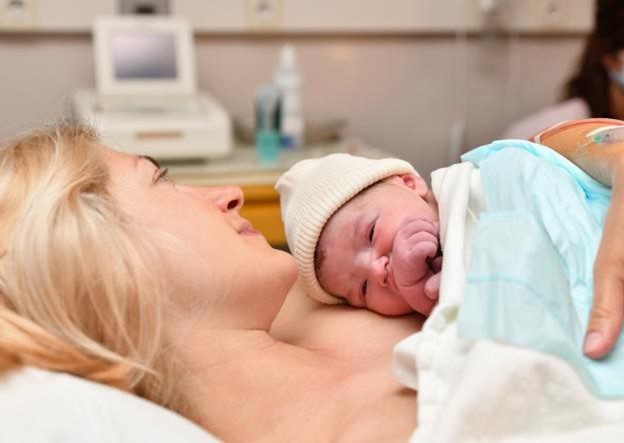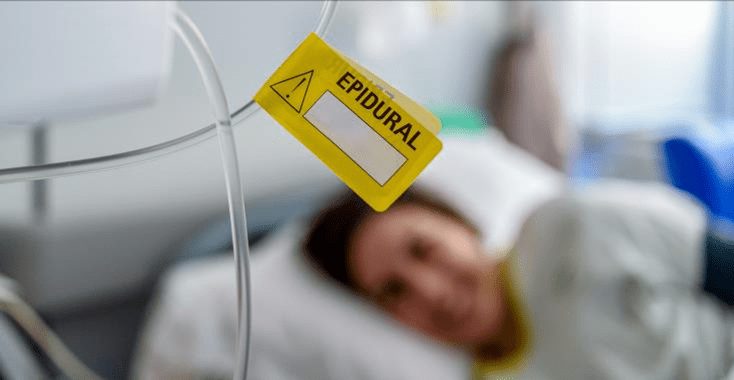Part 1: Birth to the Delivery of Your Placenta
SEPTEMBER 9, 2021 BY JULIANA PARKER, RNC-OB, C-EFM
Do not consider the opinions expressed here as medical advice (click to read more)
TABLE OF CONTENTS
Hospital Labor Rooms
Let’s review the two types of hospital settings for labor and delivery. The first type has a labor and delivery (L&D) unit with a completely separate postpartum unit. In this unit, you will have labor and delivery nurses who help you through your contractions and childbirth (vaginal or c-section), then once stable, you will be taken to a different unit and be assigned to postpartum nurses who specializes in postpartum and newborn care. This type of unit is typically found in larger hospitals.
The second type of hospital setting for labor and delivery is a combined labor, delivery, recovery and postpartum room. This room type is also referred to as an “LDRP”. In this setup, your labor and delivery nurse will become your postpartum nurse and continues to care for you during your postpartum period.
Regardless of your room type, you will labor and deliver (as long as it’s a vaginal birth) in the L&D or LDRP room. Side note – these rooms are always private. The moment your precious little baby arrives, you officially enter your acute recovery phase. Acute recovery typically lasts between 1-2 hours and involves quite a bit of activity which we will now discuss.
Newborn Stimulation
Once your baby arrives, your baby will be stimulated and dried by your labor and delivery nurse. This stimulation commonly takes place on your lower abdomen. The length of the umbilical cord determines how high they can place the baby on your abdomen. If your baby is “stunned” by the birth or is having difficulty with breathing when they are born, your baby’s umbilical cord will quickly be cut by the doctor and your nurse will take your baby to the baby warmer in your labor room. Stimulation will occur there, as well as any resuscitation efforts needed to help your baby begin breathing. Important note – babies do not always breath at birth and may need resuscitation to help them breath. This resuscitation can range from stimulation all the way to CPR. Labor and delivery nurses are trained to help your baby and in a very large majority where babies do not breath, they require only need stimulation and are crying in under a minute from their delivery time.

Delayed Cord Clamping
When your baby is born, your baby’s blood volume immediately drops. If your baby is breathing without difficulty, most doctors will delay clamping and cutting their umbilical cord (also referred to as pulsing the cord). This allows your baby’s blood volume to increase before your baby is separated. Typical delay times are 25 seconds – 5 minutes.
Cutting the Umbilical Cord
Once the cord is clamped, your provider will offer your support person the opportunity to cut your baby’s umbilical cord. If your support person would like to get a sense of what this will feel like, you can take 4 gummy worms gently twist them and try to cut through them. It will be a good practice run! Don’t worry, there is no skill needed. Cutting the cord does not hurt your baby nor mom and you have no affect on how the belly button forms.

Skin-To-Skin
Your baby is now separated and your baby will be brought up to your chest. You will be offered the opportunity to begin skin-to-skin with your baby. There are incredible benefits to implementing skin-to-skin with your baby including keeping your baby warm. If babies become cold after birth, it can lead to complications including a drop in their blood sugar levels which will need to be treated quickly to prevent admission to the NICU. An important tip, bras get in the way of skin-to-skin. Some women like to wear bras during labor, if you feel more comfortable in a bra, try to get a front opening bra so that it can easily be moved out of way for full skin-to-skin contact with your baby. Tip: Your partner can do skin-to-skin with your baby as well! If you need to rest, this is a great bonding exercise and partner skin-to-skin is just as amazing for your baby.
A Visit from the NICU Team
If your delivery involves a vacuum, forceps, meconium or a baby displaying distress, there is a good possibility that the NICU team will present for delivery. If they are present, when your baby is born, after the umbilical cord is cut, the baby will be given to the NICU team for assessment. This assessment occurs in your labor room and may temporarily delay skin-to-skin and feeding.

Umbilical Cord Blood Banking
If you are planning to save or donate your baby’s umbilical cord blood, it occurs between the cutting of the cord and the delivery of the placenta. This is a painless procedure where the doctor places a needle into the umbilical vein and drains as much umbilical cord blood into a collection bag. If you opt to collect or donate your baby’s umbilical cord stem cells, you will need to bring a kit with you. This is provided by the company you choose for storage or by the company you use for donation. Note: Don’t forget your kit. Hospitals sometimes offer back-up kits, but this is not always a guarantee.
Delivery of the Placenta
The cord has now been cut and your doctor will be waiting for your placenta to deliver. To help facilitate the delivery of your placenta, your doctor may rub your stomach right around your belly button which is where the top of your uterus is now located to help the placenta expel. This is a bit of an awkward, uncomfortable feeling and may cause some discomfort as well. It’s quick and temporary but may be unexpected. The doctor may ask you to give a gentle push (like having a bowel movement) when the placenta is ready to deliver. Once the placenta delivers, it will be examined to ensure it is intact and then it will be tossed in the medical waste or sent to pathology for examination (upon your doctor’s request). If you are planning to keep the placenta, you will be required to sign a release form. Make sure you bring a cooler to the hospital and a plastic bag. It is now considered your property and we will not be able to store it.

Turning Off the Epidural
If you have an epidural – somewhere between the baby delivering and the placenta delivering, your nurse will usually turn off your epidural. There are occasions when your doctor may request to keep it running to keep you comfortable during what they feel may be a lengthy repair.
Unexpected Scenarios
If your recovery becomes eventful, the hospital staff will jump into action. Examples mostly surround a placenta that will not deliver, a uterus that will not tighten or firm which may both lead to heavier bleeding than expected. In these rare events, (please notice the word rare), additional medications may be administered, extra manual uterine massage will be performed and if necessary, we may transfer you to an operating room so that your doctor may perform procedures to stop your bleeding.
Sedation and monitoring will be administered by an anesthesiologist and if you lose too much blood, a blood transfusion may be necessary.
When events like this occur, it is not uncommon for your partner to become overwhelmed and scared. If necessary, the NICU staff will monitor your baby until you are back in the room or until your partner feels comfortable watching your baby.
Many women have more discomfort when these circumstances arise due your doctor’s need to manually manipulate your uterus. It can make your recovery more difficult and make you feel like you were punched in the stomach multiple times. Your doctor will, if needed, prescribe stronger pain medication to help you stay comfortable.
Conclusion
From the time your baby is born to the time your placenta delivers may leave you feeling very excited or very exhausted. Some new mothers are eager and ready to hold their babies while others may need a moment to regroup and may ask their partner to hold the baby for a bit or request a crib. Every experience is unique and different and there is no right or wrong as long as you are taking steps to help YOU feel better.
Are you ready to learn more about recovery? Continue learning with Part 2A Mom’s Journey: Vaginal Birth – From Placenta Delivery to End of Acute Recovery.
Featured Courses

The Childbirth Master Class
If you are pregnant and want a vaginal birth, with or without medication, then start here. Learn about the entire birthing process including all interventions and ways to increase your chance of success!

Elementary Newborn Care
If you have little or no experience with babies, then you won’t want to miss this program. We will cover everything you need to know about your newborn from simply holding to changing diapers!

Childproofing and CPR
Learn to set up a safe environment, avoid unintentional accidents and manage emergencies. You’ll learn how to save a life in less time than it takes to watch a great movie!


